STAT6001: Public Health Informatics Report on ICT in Healthcare
VerifiedAdded on 2022/08/17
|13
|3636
|13
Report
AI Summary
This report provides a comprehensive overview of public health informatics, exploring the application of Information and Communication Technologies (ICTs) in healthcare. The report analyzes the role of ICT in public health management, highlighting its significance in improving healthcare access, communication, and data storage. It examines global and national legislation and strategies governing ICT applications in health, including the eHealth Strategy for New South Wales and the WHO's Global Strategy on Digital Health. The report assesses the effectiveness of ICT projects, evaluates innovative uses such as telemedicine and social media, and discusses the constraints to the practical application of ICT in the field. The analysis includes a review of Twitter accounts related to public health, summarizing the key insights gained from following these feeds. The report emphasizes the importance of ICT in enhancing public health outcomes, facilitating teamwork, and improving healthcare delivery.
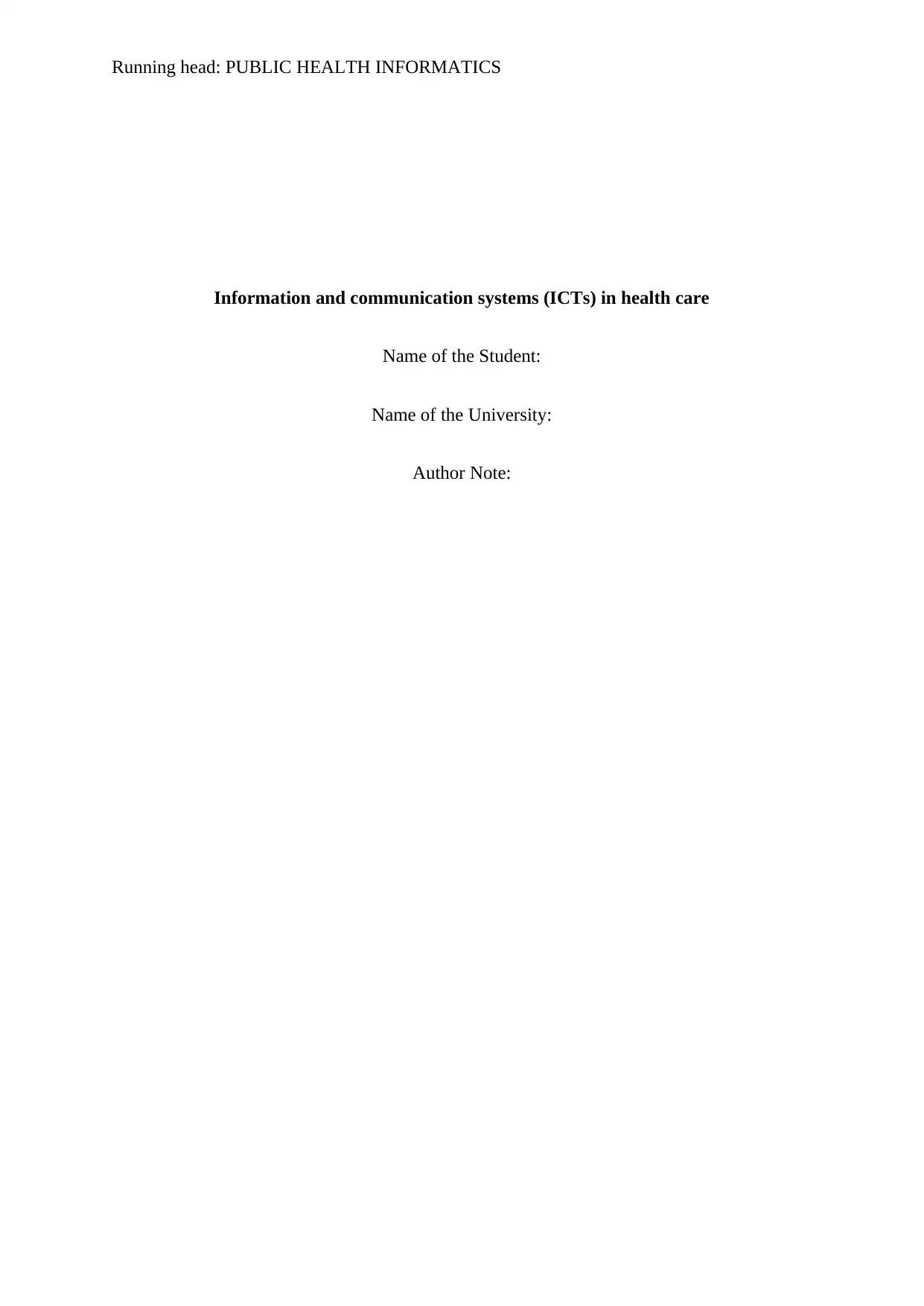
Running head: PUBLIC HEALTH INFORMATICS
Information and communication systems (ICTs) in health care
Name of the Student:
Name of the University:
Author Note:
Information and communication systems (ICTs) in health care
Name of the Student:
Name of the University:
Author Note:
Paraphrase This Document
Need a fresh take? Get an instant paraphrase of this document with our AI Paraphraser
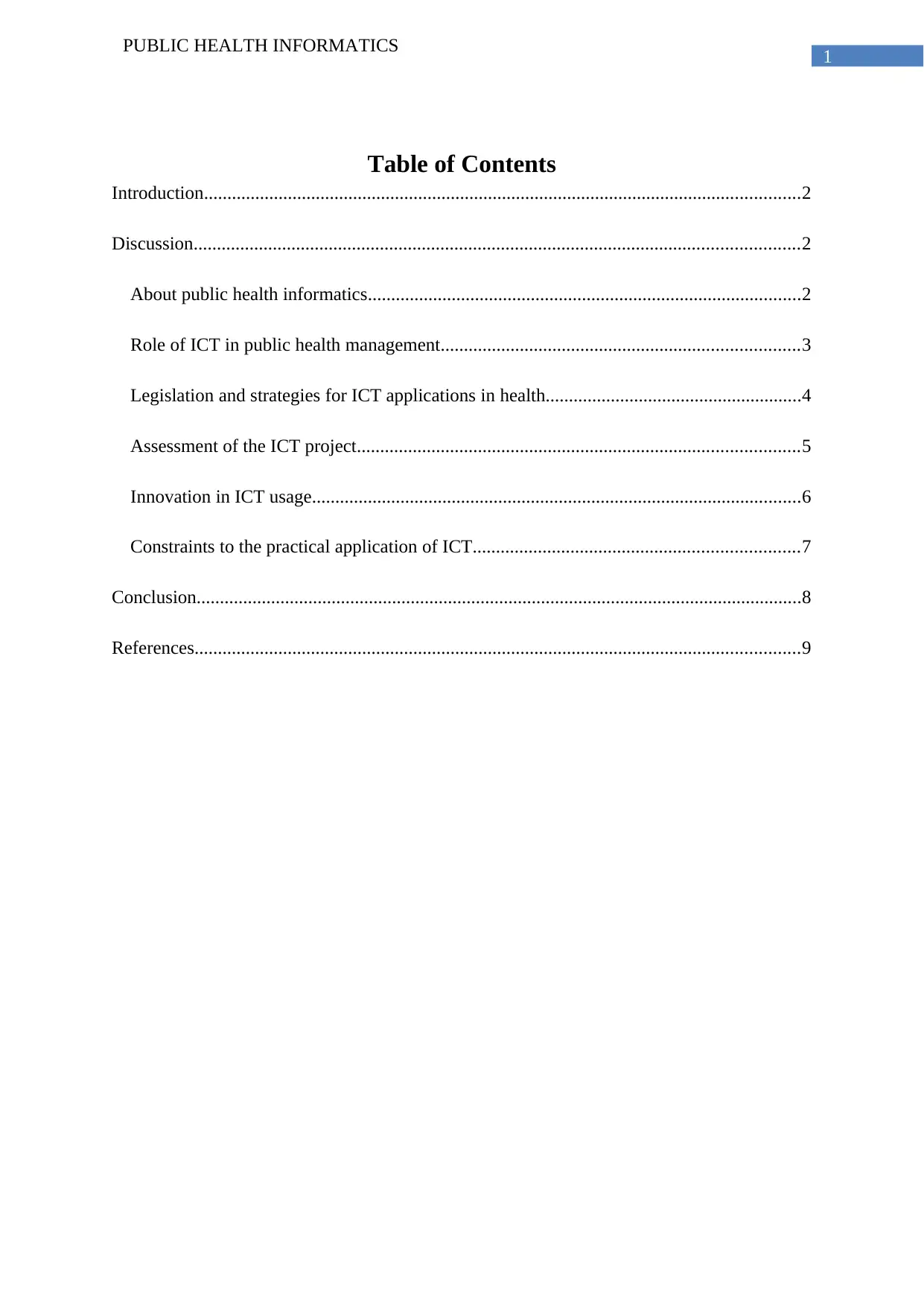
1
PUBLIC HEALTH INFORMATICS
Table of Contents
Introduction................................................................................................................................2
Discussion..................................................................................................................................2
About public health informatics.............................................................................................2
Role of ICT in public health management.............................................................................3
Legislation and strategies for ICT applications in health.......................................................4
Assessment of the ICT project...............................................................................................5
Innovation in ICT usage.........................................................................................................6
Constraints to the practical application of ICT......................................................................7
Conclusion..................................................................................................................................8
References..................................................................................................................................9
PUBLIC HEALTH INFORMATICS
Table of Contents
Introduction................................................................................................................................2
Discussion..................................................................................................................................2
About public health informatics.............................................................................................2
Role of ICT in public health management.............................................................................3
Legislation and strategies for ICT applications in health.......................................................4
Assessment of the ICT project...............................................................................................5
Innovation in ICT usage.........................................................................................................6
Constraints to the practical application of ICT......................................................................7
Conclusion..................................................................................................................................8
References..................................................................................................................................9
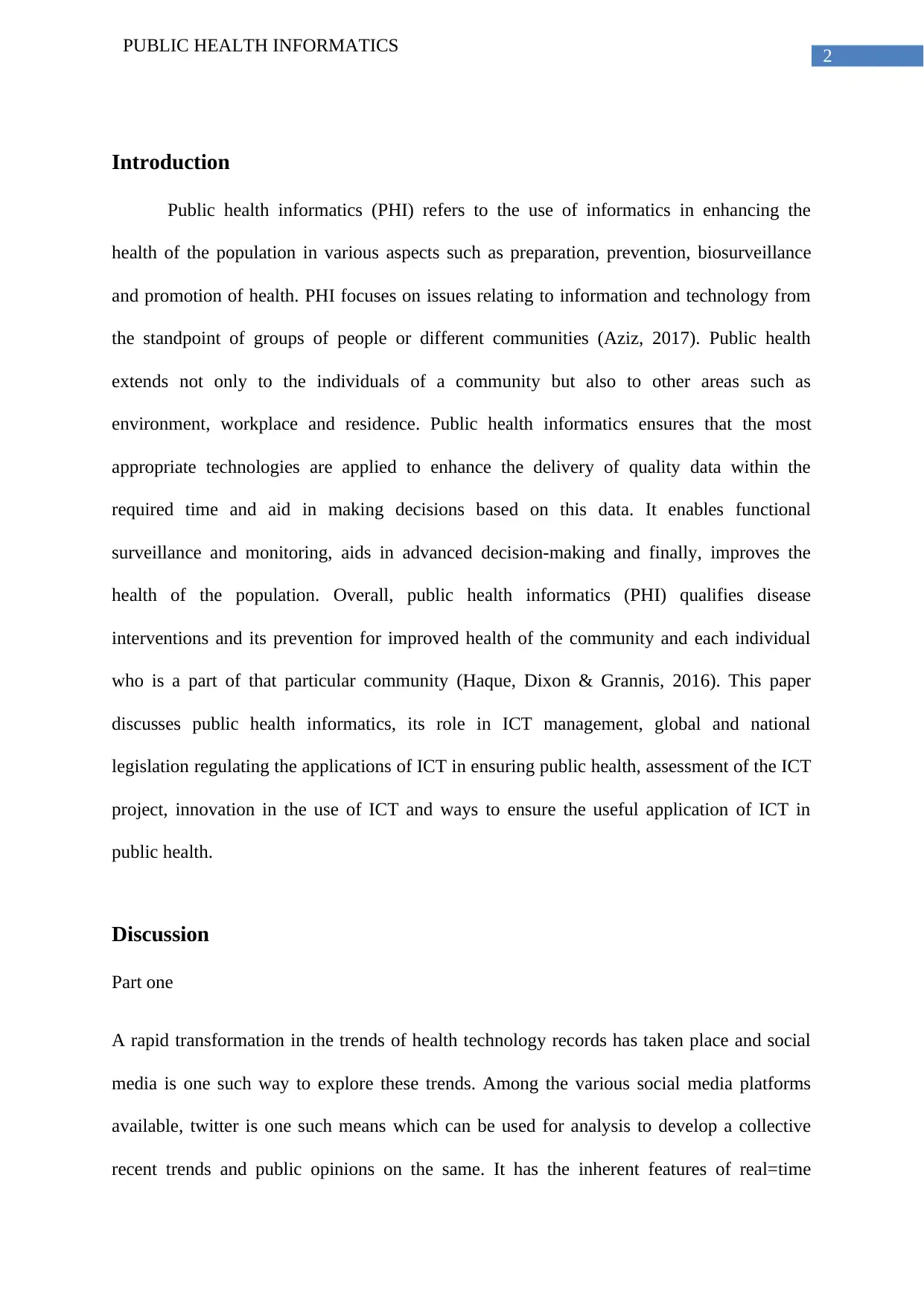
2
PUBLIC HEALTH INFORMATICS
Introduction
Public health informatics (PHI) refers to the use of informatics in enhancing the
health of the population in various aspects such as preparation, prevention, biosurveillance
and promotion of health. PHI focuses on issues relating to information and technology from
the standpoint of groups of people or different communities (Aziz, 2017). Public health
extends not only to the individuals of a community but also to other areas such as
environment, workplace and residence. Public health informatics ensures that the most
appropriate technologies are applied to enhance the delivery of quality data within the
required time and aid in making decisions based on this data. It enables functional
surveillance and monitoring, aids in advanced decision-making and finally, improves the
health of the population. Overall, public health informatics (PHI) qualifies disease
interventions and its prevention for improved health of the community and each individual
who is a part of that particular community (Haque, Dixon & Grannis, 2016). This paper
discusses public health informatics, its role in ICT management, global and national
legislation regulating the applications of ICT in ensuring public health, assessment of the ICT
project, innovation in the use of ICT and ways to ensure the useful application of ICT in
public health.
Discussion
Part one
A rapid transformation in the trends of health technology records has taken place and social
media is one such way to explore these trends. Among the various social media platforms
available, twitter is one such means which can be used for analysis to develop a collective
recent trends and public opinions on the same. It has the inherent features of real=time
PUBLIC HEALTH INFORMATICS
Introduction
Public health informatics (PHI) refers to the use of informatics in enhancing the
health of the population in various aspects such as preparation, prevention, biosurveillance
and promotion of health. PHI focuses on issues relating to information and technology from
the standpoint of groups of people or different communities (Aziz, 2017). Public health
extends not only to the individuals of a community but also to other areas such as
environment, workplace and residence. Public health informatics ensures that the most
appropriate technologies are applied to enhance the delivery of quality data within the
required time and aid in making decisions based on this data. It enables functional
surveillance and monitoring, aids in advanced decision-making and finally, improves the
health of the population. Overall, public health informatics (PHI) qualifies disease
interventions and its prevention for improved health of the community and each individual
who is a part of that particular community (Haque, Dixon & Grannis, 2016). This paper
discusses public health informatics, its role in ICT management, global and national
legislation regulating the applications of ICT in ensuring public health, assessment of the ICT
project, innovation in the use of ICT and ways to ensure the useful application of ICT in
public health.
Discussion
Part one
A rapid transformation in the trends of health technology records has taken place and social
media is one such way to explore these trends. Among the various social media platforms
available, twitter is one such means which can be used for analysis to develop a collective
recent trends and public opinions on the same. It has the inherent features of real=time
⊘ This is a preview!⊘
Do you want full access?
Subscribe today to unlock all pages.

Trusted by 1+ million students worldwide
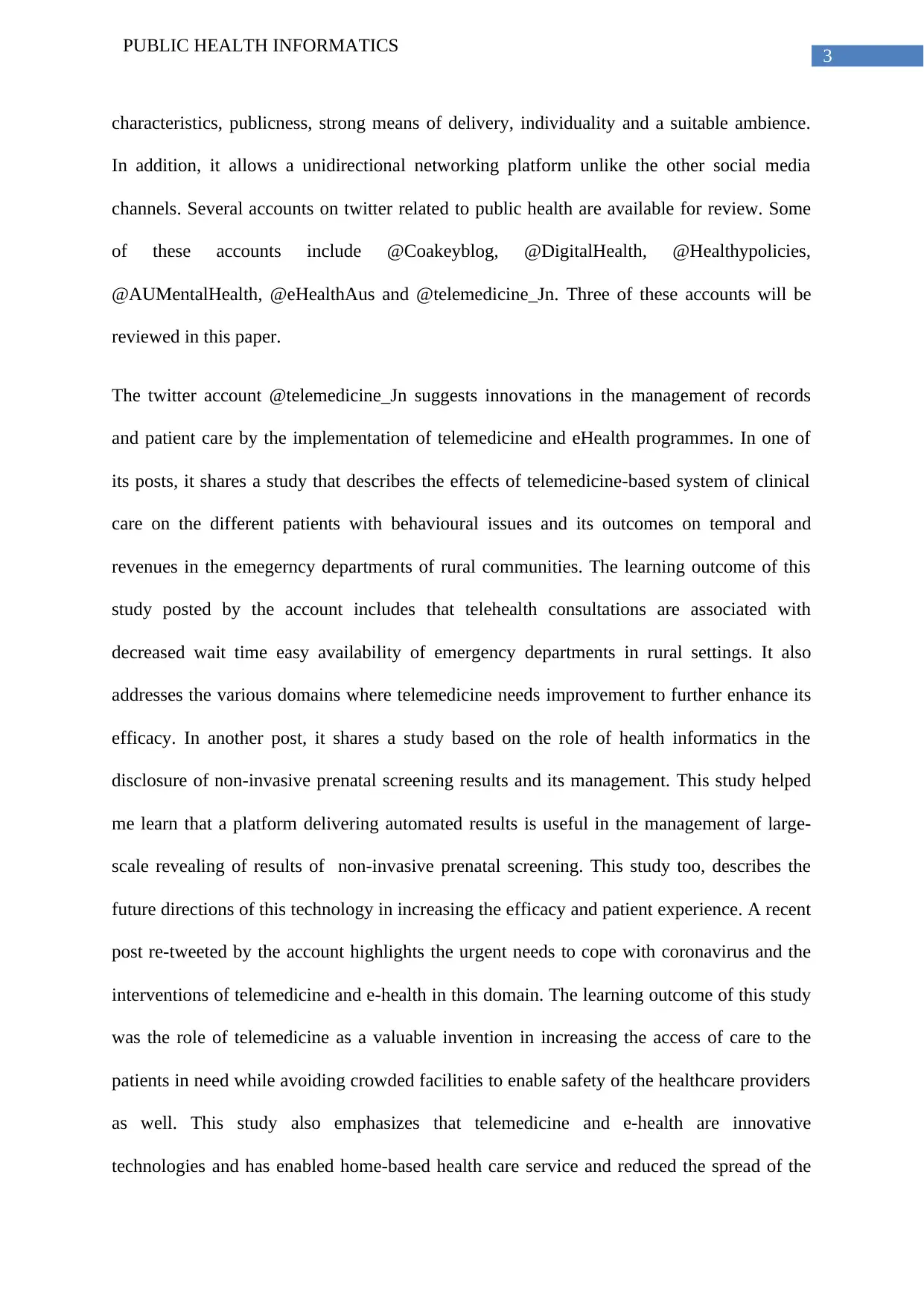
3
PUBLIC HEALTH INFORMATICS
characteristics, publicness, strong means of delivery, individuality and a suitable ambience.
In addition, it allows a unidirectional networking platform unlike the other social media
channels. Several accounts on twitter related to public health are available for review. Some
of these accounts include @Coakeyblog, @DigitalHealth, @Healthypolicies,
@AUMentalHealth, @eHealthAus and @telemedicine_Jn. Three of these accounts will be
reviewed in this paper.
The twitter account @telemedicine_Jn suggests innovations in the management of records
and patient care by the implementation of telemedicine and eHealth programmes. In one of
its posts, it shares a study that describes the effects of telemedicine-based system of clinical
care on the different patients with behavioural issues and its outcomes on temporal and
revenues in the emegerncy departments of rural communities. The learning outcome of this
study posted by the account includes that telehealth consultations are associated with
decreased wait time easy availability of emergency departments in rural settings. It also
addresses the various domains where telemedicine needs improvement to further enhance its
efficacy. In another post, it shares a study based on the role of health informatics in the
disclosure of non-invasive prenatal screening results and its management. This study helped
me learn that a platform delivering automated results is useful in the management of large-
scale revealing of results of non-invasive prenatal screening. This study too, describes the
future directions of this technology in increasing the efficacy and patient experience. A recent
post re-tweeted by the account highlights the urgent needs to cope with coronavirus and the
interventions of telemedicine and e-health in this domain. The learning outcome of this study
was the role of telemedicine as a valuable invention in increasing the access of care to the
patients in need while avoiding crowded facilities to enable safety of the healthcare providers
as well. This study also emphasizes that telemedicine and e-health are innovative
technologies and has enabled home-based health care service and reduced the spread of the
PUBLIC HEALTH INFORMATICS
characteristics, publicness, strong means of delivery, individuality and a suitable ambience.
In addition, it allows a unidirectional networking platform unlike the other social media
channels. Several accounts on twitter related to public health are available for review. Some
of these accounts include @Coakeyblog, @DigitalHealth, @Healthypolicies,
@AUMentalHealth, @eHealthAus and @telemedicine_Jn. Three of these accounts will be
reviewed in this paper.
The twitter account @telemedicine_Jn suggests innovations in the management of records
and patient care by the implementation of telemedicine and eHealth programmes. In one of
its posts, it shares a study that describes the effects of telemedicine-based system of clinical
care on the different patients with behavioural issues and its outcomes on temporal and
revenues in the emegerncy departments of rural communities. The learning outcome of this
study posted by the account includes that telehealth consultations are associated with
decreased wait time easy availability of emergency departments in rural settings. It also
addresses the various domains where telemedicine needs improvement to further enhance its
efficacy. In another post, it shares a study based on the role of health informatics in the
disclosure of non-invasive prenatal screening results and its management. This study helped
me learn that a platform delivering automated results is useful in the management of large-
scale revealing of results of non-invasive prenatal screening. This study too, describes the
future directions of this technology in increasing the efficacy and patient experience. A recent
post re-tweeted by the account highlights the urgent needs to cope with coronavirus and the
interventions of telemedicine and e-health in this domain. The learning outcome of this study
was the role of telemedicine as a valuable invention in increasing the access of care to the
patients in need while avoiding crowded facilities to enable safety of the healthcare providers
as well. This study also emphasizes that telemedicine and e-health are innovative
technologies and has enabled home-based health care service and reduced the spread of the
Paraphrase This Document
Need a fresh take? Get an instant paraphrase of this document with our AI Paraphraser
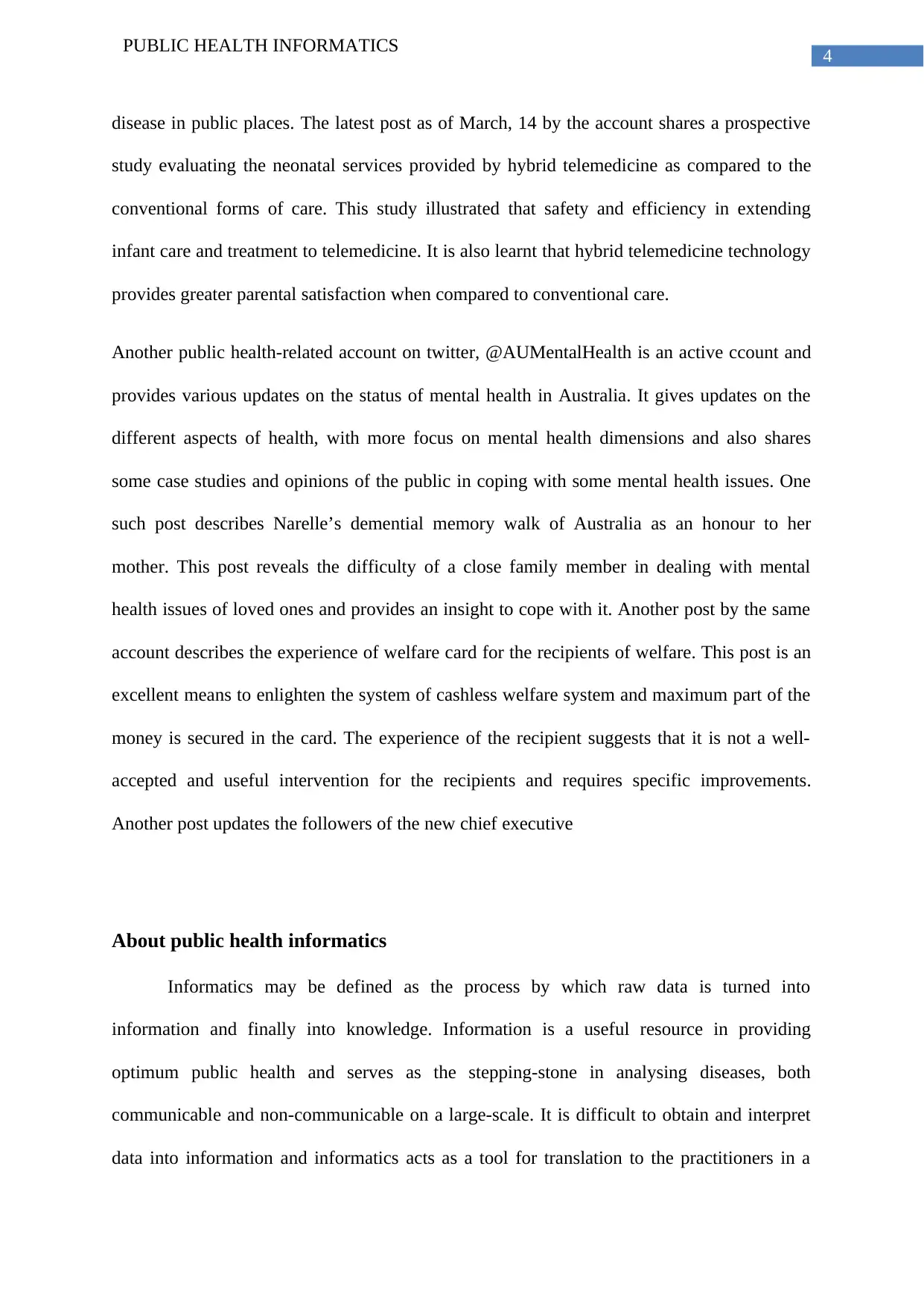
4
PUBLIC HEALTH INFORMATICS
disease in public places. The latest post as of March, 14 by the account shares a prospective
study evaluating the neonatal services provided by hybrid telemedicine as compared to the
conventional forms of care. This study illustrated that safety and efficiency in extending
infant care and treatment to telemedicine. It is also learnt that hybrid telemedicine technology
provides greater parental satisfaction when compared to conventional care.
Another public health-related account on twitter, @AUMentalHealth is an active ccount and
provides various updates on the status of mental health in Australia. It gives updates on the
different aspects of health, with more focus on mental health dimensions and also shares
some case studies and opinions of the public in coping with some mental health issues. One
such post describes Narelle’s demential memory walk of Australia as an honour to her
mother. This post reveals the difficulty of a close family member in dealing with mental
health issues of loved ones and provides an insight to cope with it. Another post by the same
account describes the experience of welfare card for the recipients of welfare. This post is an
excellent means to enlighten the system of cashless welfare system and maximum part of the
money is secured in the card. The experience of the recipient suggests that it is not a well-
accepted and useful intervention for the recipients and requires specific improvements.
Another post updates the followers of the new chief executive
About public health informatics
Informatics may be defined as the process by which raw data is turned into
information and finally into knowledge. Information is a useful resource in providing
optimum public health and serves as the stepping-stone in analysing diseases, both
communicable and non-communicable on a large-scale. It is difficult to obtain and interpret
data into information and informatics acts as a tool for translation to the practitioners in a
PUBLIC HEALTH INFORMATICS
disease in public places. The latest post as of March, 14 by the account shares a prospective
study evaluating the neonatal services provided by hybrid telemedicine as compared to the
conventional forms of care. This study illustrated that safety and efficiency in extending
infant care and treatment to telemedicine. It is also learnt that hybrid telemedicine technology
provides greater parental satisfaction when compared to conventional care.
Another public health-related account on twitter, @AUMentalHealth is an active ccount and
provides various updates on the status of mental health in Australia. It gives updates on the
different aspects of health, with more focus on mental health dimensions and also shares
some case studies and opinions of the public in coping with some mental health issues. One
such post describes Narelle’s demential memory walk of Australia as an honour to her
mother. This post reveals the difficulty of a close family member in dealing with mental
health issues of loved ones and provides an insight to cope with it. Another post by the same
account describes the experience of welfare card for the recipients of welfare. This post is an
excellent means to enlighten the system of cashless welfare system and maximum part of the
money is secured in the card. The experience of the recipient suggests that it is not a well-
accepted and useful intervention for the recipients and requires specific improvements.
Another post updates the followers of the new chief executive
About public health informatics
Informatics may be defined as the process by which raw data is turned into
information and finally into knowledge. Information is a useful resource in providing
optimum public health and serves as the stepping-stone in analysing diseases, both
communicable and non-communicable on a large-scale. It is difficult to obtain and interpret
data into information and informatics acts as a tool for translation to the practitioners in a
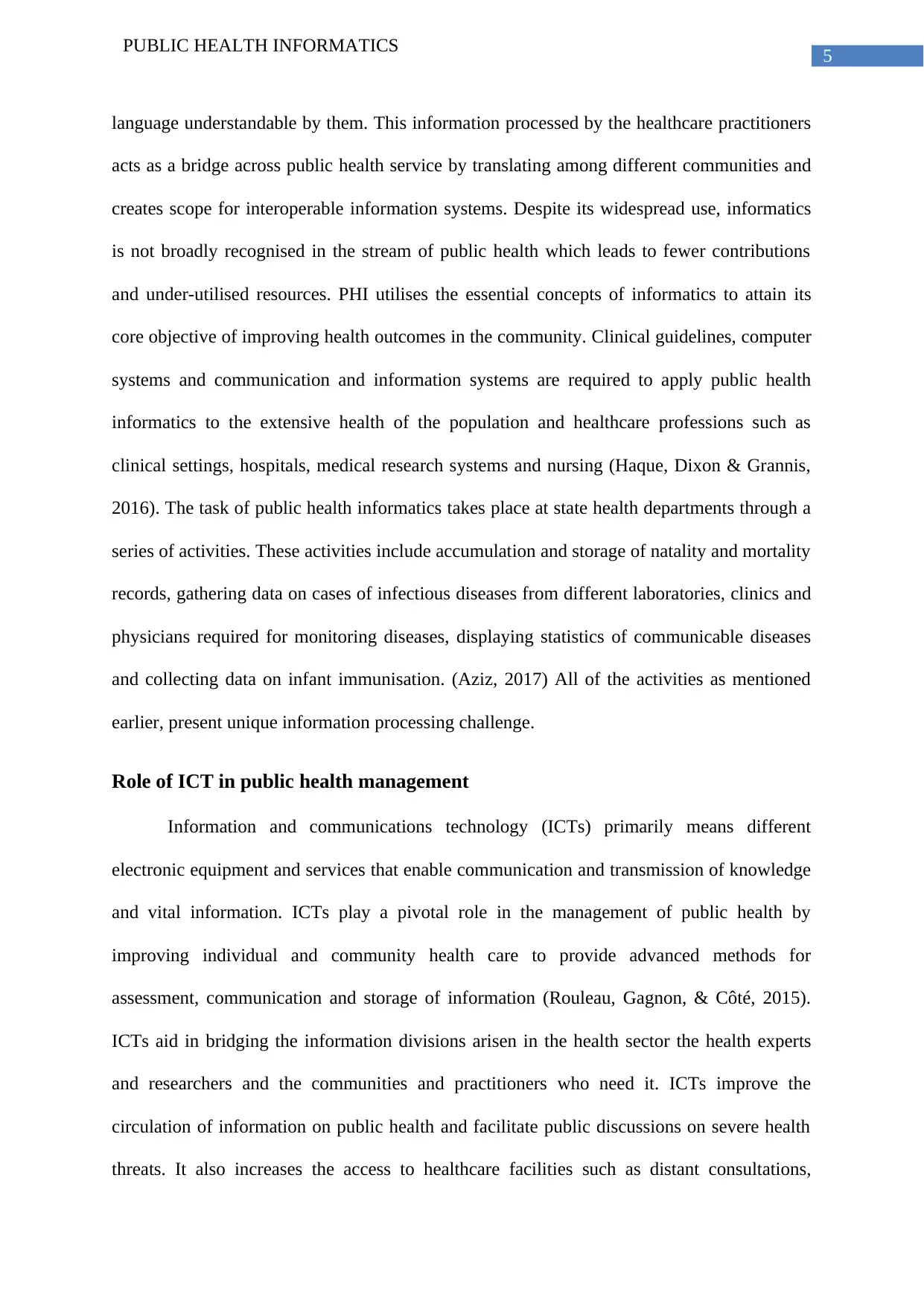
5
PUBLIC HEALTH INFORMATICS
language understandable by them. This information processed by the healthcare practitioners
acts as a bridge across public health service by translating among different communities and
creates scope for interoperable information systems. Despite its widespread use, informatics
is not broadly recognised in the stream of public health which leads to fewer contributions
and under-utilised resources. PHI utilises the essential concepts of informatics to attain its
core objective of improving health outcomes in the community. Clinical guidelines, computer
systems and communication and information systems are required to apply public health
informatics to the extensive health of the population and healthcare professions such as
clinical settings, hospitals, medical research systems and nursing (Haque, Dixon & Grannis,
2016). The task of public health informatics takes place at state health departments through a
series of activities. These activities include accumulation and storage of natality and mortality
records, gathering data on cases of infectious diseases from different laboratories, clinics and
physicians required for monitoring diseases, displaying statistics of communicable diseases
and collecting data on infant immunisation. (Aziz, 2017) All of the activities as mentioned
earlier, present unique information processing challenge.
Role of ICT in public health management
Information and communications technology (ICTs) primarily means different
electronic equipment and services that enable communication and transmission of knowledge
and vital information. ICTs play a pivotal role in the management of public health by
improving individual and community health care to provide advanced methods for
assessment, communication and storage of information (Rouleau, Gagnon, & Côté, 2015).
ICTs aid in bridging the information divisions arisen in the health sector the health experts
and researchers and the communities and practitioners who need it. ICTs improve the
circulation of information on public health and facilitate public discussions on severe health
threats. It also increases the access to healthcare facilities such as distant consultations,
PUBLIC HEALTH INFORMATICS
language understandable by them. This information processed by the healthcare practitioners
acts as a bridge across public health service by translating among different communities and
creates scope for interoperable information systems. Despite its widespread use, informatics
is not broadly recognised in the stream of public health which leads to fewer contributions
and under-utilised resources. PHI utilises the essential concepts of informatics to attain its
core objective of improving health outcomes in the community. Clinical guidelines, computer
systems and communication and information systems are required to apply public health
informatics to the extensive health of the population and healthcare professions such as
clinical settings, hospitals, medical research systems and nursing (Haque, Dixon & Grannis,
2016). The task of public health informatics takes place at state health departments through a
series of activities. These activities include accumulation and storage of natality and mortality
records, gathering data on cases of infectious diseases from different laboratories, clinics and
physicians required for monitoring diseases, displaying statistics of communicable diseases
and collecting data on infant immunisation. (Aziz, 2017) All of the activities as mentioned
earlier, present unique information processing challenge.
Role of ICT in public health management
Information and communications technology (ICTs) primarily means different
electronic equipment and services that enable communication and transmission of knowledge
and vital information. ICTs play a pivotal role in the management of public health by
improving individual and community health care to provide advanced methods for
assessment, communication and storage of information (Rouleau, Gagnon, & Côté, 2015).
ICTs aid in bridging the information divisions arisen in the health sector the health experts
and researchers and the communities and practitioners who need it. ICTs improve the
circulation of information on public health and facilitate public discussions on severe health
threats. It also increases the access to healthcare facilities such as distant consultations,
⊘ This is a preview!⊘
Do you want full access?
Subscribe today to unlock all pages.

Trusted by 1+ million students worldwide
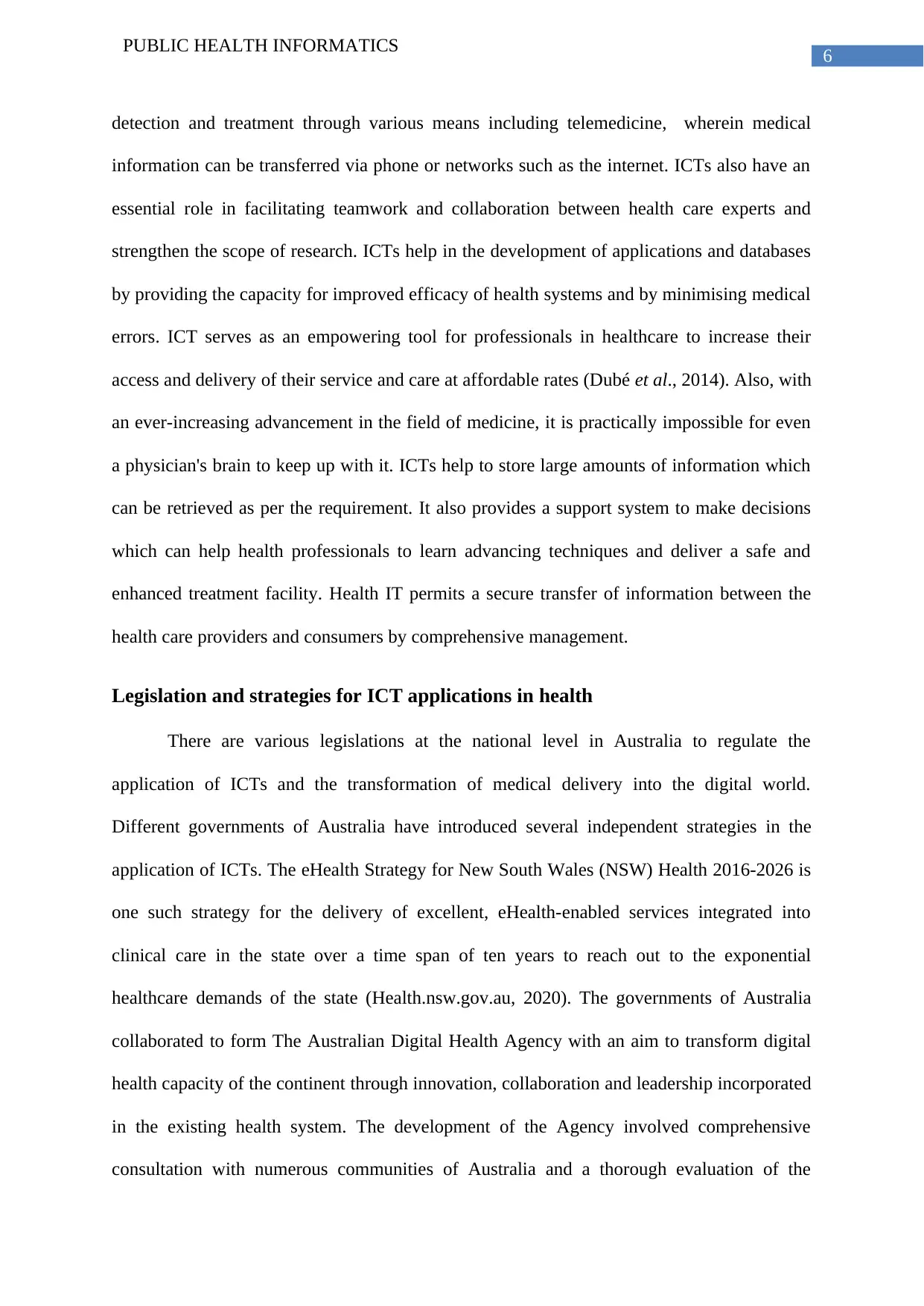
6
PUBLIC HEALTH INFORMATICS
detection and treatment through various means including telemedicine, wherein medical
information can be transferred via phone or networks such as the internet. ICTs also have an
essential role in facilitating teamwork and collaboration between health care experts and
strengthen the scope of research. ICTs help in the development of applications and databases
by providing the capacity for improved efficacy of health systems and by minimising medical
errors. ICT serves as an empowering tool for professionals in healthcare to increase their
access and delivery of their service and care at affordable rates (Dubé et al., 2014). Also, with
an ever-increasing advancement in the field of medicine, it is practically impossible for even
a physician's brain to keep up with it. ICTs help to store large amounts of information which
can be retrieved as per the requirement. It also provides a support system to make decisions
which can help health professionals to learn advancing techniques and deliver a safe and
enhanced treatment facility. Health IT permits a secure transfer of information between the
health care providers and consumers by comprehensive management.
Legislation and strategies for ICT applications in health
There are various legislations at the national level in Australia to regulate the
application of ICTs and the transformation of medical delivery into the digital world.
Different governments of Australia have introduced several independent strategies in the
application of ICTs. The eHealth Strategy for New South Wales (NSW) Health 2016-2026 is
one such strategy for the delivery of excellent, eHealth-enabled services integrated into
clinical care in the state over a time span of ten years to reach out to the exponential
healthcare demands of the state (Health.nsw.gov.au, 2020). The governments of Australia
collaborated to form The Australian Digital Health Agency with an aim to transform digital
health capacity of the continent through innovation, collaboration and leadership incorporated
in the existing health system. The development of the Agency involved comprehensive
consultation with numerous communities of Australia and a thorough evaluation of the
PUBLIC HEALTH INFORMATICS
detection and treatment through various means including telemedicine, wherein medical
information can be transferred via phone or networks such as the internet. ICTs also have an
essential role in facilitating teamwork and collaboration between health care experts and
strengthen the scope of research. ICTs help in the development of applications and databases
by providing the capacity for improved efficacy of health systems and by minimising medical
errors. ICT serves as an empowering tool for professionals in healthcare to increase their
access and delivery of their service and care at affordable rates (Dubé et al., 2014). Also, with
an ever-increasing advancement in the field of medicine, it is practically impossible for even
a physician's brain to keep up with it. ICTs help to store large amounts of information which
can be retrieved as per the requirement. It also provides a support system to make decisions
which can help health professionals to learn advancing techniques and deliver a safe and
enhanced treatment facility. Health IT permits a secure transfer of information between the
health care providers and consumers by comprehensive management.
Legislation and strategies for ICT applications in health
There are various legislations at the national level in Australia to regulate the
application of ICTs and the transformation of medical delivery into the digital world.
Different governments of Australia have introduced several independent strategies in the
application of ICTs. The eHealth Strategy for New South Wales (NSW) Health 2016-2026 is
one such strategy for the delivery of excellent, eHealth-enabled services integrated into
clinical care in the state over a time span of ten years to reach out to the exponential
healthcare demands of the state (Health.nsw.gov.au, 2020). The governments of Australia
collaborated to form The Australian Digital Health Agency with an aim to transform digital
health capacity of the continent through innovation, collaboration and leadership incorporated
in the existing health system. The development of the Agency involved comprehensive
consultation with numerous communities of Australia and a thorough evaluation of the
Paraphrase This Document
Need a fresh take? Get an instant paraphrase of this document with our AI Paraphraser
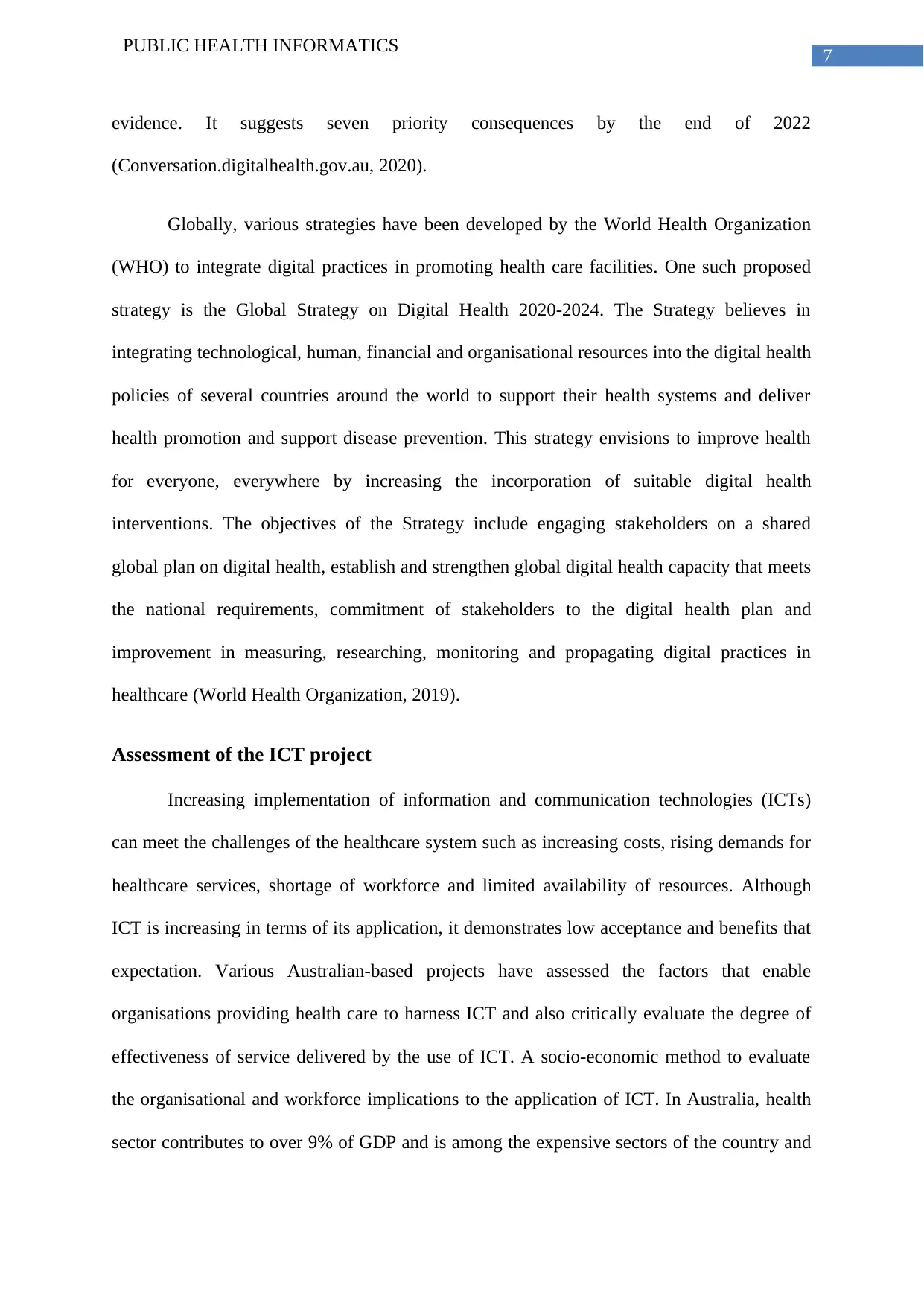
7
PUBLIC HEALTH INFORMATICS
evidence. It suggests seven priority consequences by the end of 2022
(Conversation.digitalhealth.gov.au, 2020).
Globally, various strategies have been developed by the World Health Organization
(WHO) to integrate digital practices in promoting health care facilities. One such proposed
strategy is the Global Strategy on Digital Health 2020-2024. The Strategy believes in
integrating technological, human, financial and organisational resources into the digital health
policies of several countries around the world to support their health systems and deliver
health promotion and support disease prevention. This strategy envisions to improve health
for everyone, everywhere by increasing the incorporation of suitable digital health
interventions. The objectives of the Strategy include engaging stakeholders on a shared
global plan on digital health, establish and strengthen global digital health capacity that meets
the national requirements, commitment of stakeholders to the digital health plan and
improvement in measuring, researching, monitoring and propagating digital practices in
healthcare (World Health Organization, 2019).
Assessment of the ICT project
Increasing implementation of information and communication technologies (ICTs)
can meet the challenges of the healthcare system such as increasing costs, rising demands for
healthcare services, shortage of workforce and limited availability of resources. Although
ICT is increasing in terms of its application, it demonstrates low acceptance and benefits that
expectation. Various Australian-based projects have assessed the factors that enable
organisations providing health care to harness ICT and also critically evaluate the degree of
effectiveness of service delivered by the use of ICT. A socio-economic method to evaluate
the organisational and workforce implications to the application of ICT. In Australia, health
sector contributes to over 9% of GDP and is among the expensive sectors of the country and
PUBLIC HEALTH INFORMATICS
evidence. It suggests seven priority consequences by the end of 2022
(Conversation.digitalhealth.gov.au, 2020).
Globally, various strategies have been developed by the World Health Organization
(WHO) to integrate digital practices in promoting health care facilities. One such proposed
strategy is the Global Strategy on Digital Health 2020-2024. The Strategy believes in
integrating technological, human, financial and organisational resources into the digital health
policies of several countries around the world to support their health systems and deliver
health promotion and support disease prevention. This strategy envisions to improve health
for everyone, everywhere by increasing the incorporation of suitable digital health
interventions. The objectives of the Strategy include engaging stakeholders on a shared
global plan on digital health, establish and strengthen global digital health capacity that meets
the national requirements, commitment of stakeholders to the digital health plan and
improvement in measuring, researching, monitoring and propagating digital practices in
healthcare (World Health Organization, 2019).
Assessment of the ICT project
Increasing implementation of information and communication technologies (ICTs)
can meet the challenges of the healthcare system such as increasing costs, rising demands for
healthcare services, shortage of workforce and limited availability of resources. Although
ICT is increasing in terms of its application, it demonstrates low acceptance and benefits that
expectation. Various Australian-based projects have assessed the factors that enable
organisations providing health care to harness ICT and also critically evaluate the degree of
effectiveness of service delivered by the use of ICT. A socio-economic method to evaluate
the organisational and workforce implications to the application of ICT. In Australia, health
sector contributes to over 9% of GDP and is among the expensive sectors of the country and
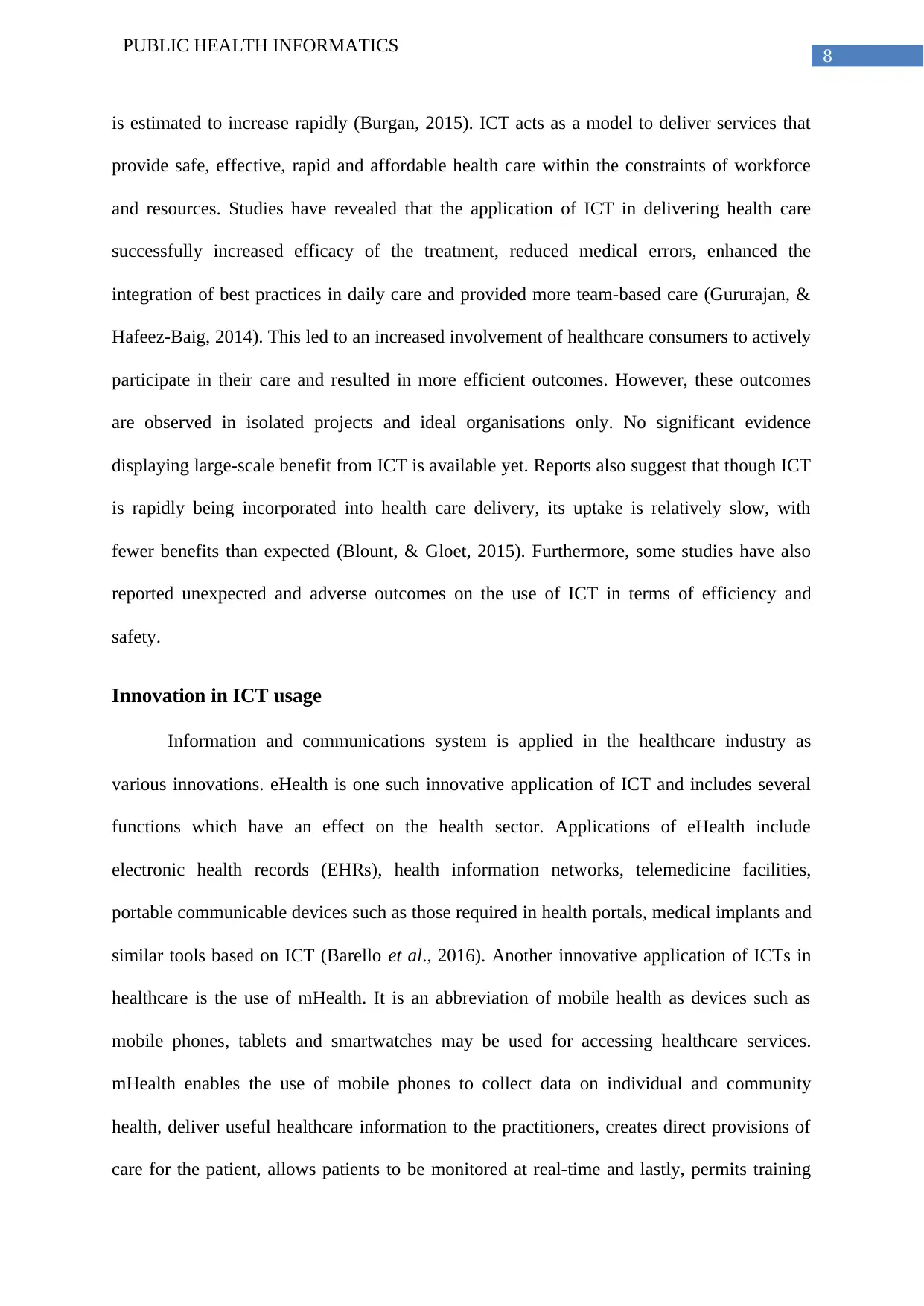
8
PUBLIC HEALTH INFORMATICS
is estimated to increase rapidly (Burgan, 2015). ICT acts as a model to deliver services that
provide safe, effective, rapid and affordable health care within the constraints of workforce
and resources. Studies have revealed that the application of ICT in delivering health care
successfully increased efficacy of the treatment, reduced medical errors, enhanced the
integration of best practices in daily care and provided more team-based care (Gururajan, &
Hafeez-Baig, 2014). This led to an increased involvement of healthcare consumers to actively
participate in their care and resulted in more efficient outcomes. However, these outcomes
are observed in isolated projects and ideal organisations only. No significant evidence
displaying large-scale benefit from ICT is available yet. Reports also suggest that though ICT
is rapidly being incorporated into health care delivery, its uptake is relatively slow, with
fewer benefits than expected (Blount, & Gloet, 2015). Furthermore, some studies have also
reported unexpected and adverse outcomes on the use of ICT in terms of efficiency and
safety.
Innovation in ICT usage
Information and communications system is applied in the healthcare industry as
various innovations. eHealth is one such innovative application of ICT and includes several
functions which have an effect on the health sector. Applications of eHealth include
electronic health records (EHRs), health information networks, telemedicine facilities,
portable communicable devices such as those required in health portals, medical implants and
similar tools based on ICT (Barello et al., 2016). Another innovative application of ICTs in
healthcare is the use of mHealth. It is an abbreviation of mobile health as devices such as
mobile phones, tablets and smartwatches may be used for accessing healthcare services.
mHealth enables the use of mobile phones to collect data on individual and community
health, deliver useful healthcare information to the practitioners, creates direct provisions of
care for the patient, allows patients to be monitored at real-time and lastly, permits training
PUBLIC HEALTH INFORMATICS
is estimated to increase rapidly (Burgan, 2015). ICT acts as a model to deliver services that
provide safe, effective, rapid and affordable health care within the constraints of workforce
and resources. Studies have revealed that the application of ICT in delivering health care
successfully increased efficacy of the treatment, reduced medical errors, enhanced the
integration of best practices in daily care and provided more team-based care (Gururajan, &
Hafeez-Baig, 2014). This led to an increased involvement of healthcare consumers to actively
participate in their care and resulted in more efficient outcomes. However, these outcomes
are observed in isolated projects and ideal organisations only. No significant evidence
displaying large-scale benefit from ICT is available yet. Reports also suggest that though ICT
is rapidly being incorporated into health care delivery, its uptake is relatively slow, with
fewer benefits than expected (Blount, & Gloet, 2015). Furthermore, some studies have also
reported unexpected and adverse outcomes on the use of ICT in terms of efficiency and
safety.
Innovation in ICT usage
Information and communications system is applied in the healthcare industry as
various innovations. eHealth is one such innovative application of ICT and includes several
functions which have an effect on the health sector. Applications of eHealth include
electronic health records (EHRs), health information networks, telemedicine facilities,
portable communicable devices such as those required in health portals, medical implants and
similar tools based on ICT (Barello et al., 2016). Another innovative application of ICTs in
healthcare is the use of mHealth. It is an abbreviation of mobile health as devices such as
mobile phones, tablets and smartwatches may be used for accessing healthcare services.
mHealth enables the use of mobile phones to collect data on individual and community
health, deliver useful healthcare information to the practitioners, creates direct provisions of
care for the patient, allows patients to be monitored at real-time and lastly, permits training
⊘ This is a preview!⊘
Do you want full access?
Subscribe today to unlock all pages.

Trusted by 1+ million students worldwide
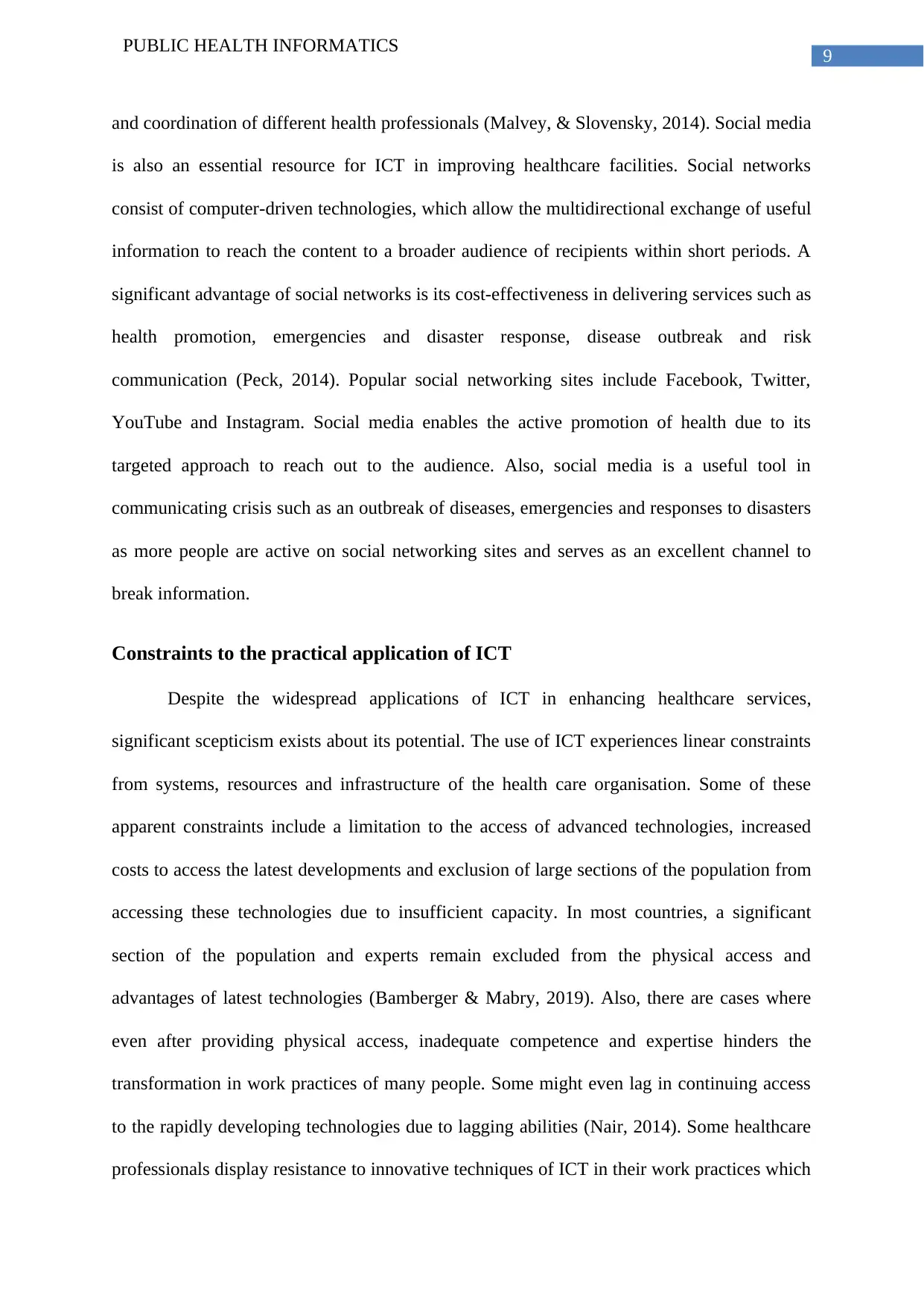
9
PUBLIC HEALTH INFORMATICS
and coordination of different health professionals (Malvey, & Slovensky, 2014). Social media
is also an essential resource for ICT in improving healthcare facilities. Social networks
consist of computer-driven technologies, which allow the multidirectional exchange of useful
information to reach the content to a broader audience of recipients within short periods. A
significant advantage of social networks is its cost-effectiveness in delivering services such as
health promotion, emergencies and disaster response, disease outbreak and risk
communication (Peck, 2014). Popular social networking sites include Facebook, Twitter,
YouTube and Instagram. Social media enables the active promotion of health due to its
targeted approach to reach out to the audience. Also, social media is a useful tool in
communicating crisis such as an outbreak of diseases, emergencies and responses to disasters
as more people are active on social networking sites and serves as an excellent channel to
break information.
Constraints to the practical application of ICT
Despite the widespread applications of ICT in enhancing healthcare services,
significant scepticism exists about its potential. The use of ICT experiences linear constraints
from systems, resources and infrastructure of the health care organisation. Some of these
apparent constraints include a limitation to the access of advanced technologies, increased
costs to access the latest developments and exclusion of large sections of the population from
accessing these technologies due to insufficient capacity. In most countries, a significant
section of the population and experts remain excluded from the physical access and
advantages of latest technologies (Bamberger & Mabry, 2019). Also, there are cases where
even after providing physical access, inadequate competence and expertise hinders the
transformation in work practices of many people. Some might even lag in continuing access
to the rapidly developing technologies due to lagging abilities (Nair, 2014). Some healthcare
professionals display resistance to innovative techniques of ICT in their work practices which
PUBLIC HEALTH INFORMATICS
and coordination of different health professionals (Malvey, & Slovensky, 2014). Social media
is also an essential resource for ICT in improving healthcare facilities. Social networks
consist of computer-driven technologies, which allow the multidirectional exchange of useful
information to reach the content to a broader audience of recipients within short periods. A
significant advantage of social networks is its cost-effectiveness in delivering services such as
health promotion, emergencies and disaster response, disease outbreak and risk
communication (Peck, 2014). Popular social networking sites include Facebook, Twitter,
YouTube and Instagram. Social media enables the active promotion of health due to its
targeted approach to reach out to the audience. Also, social media is a useful tool in
communicating crisis such as an outbreak of diseases, emergencies and responses to disasters
as more people are active on social networking sites and serves as an excellent channel to
break information.
Constraints to the practical application of ICT
Despite the widespread applications of ICT in enhancing healthcare services,
significant scepticism exists about its potential. The use of ICT experiences linear constraints
from systems, resources and infrastructure of the health care organisation. Some of these
apparent constraints include a limitation to the access of advanced technologies, increased
costs to access the latest developments and exclusion of large sections of the population from
accessing these technologies due to insufficient capacity. In most countries, a significant
section of the population and experts remain excluded from the physical access and
advantages of latest technologies (Bamberger & Mabry, 2019). Also, there are cases where
even after providing physical access, inadequate competence and expertise hinders the
transformation in work practices of many people. Some might even lag in continuing access
to the rapidly developing technologies due to lagging abilities (Nair, 2014). Some healthcare
professionals display resistance to innovative techniques of ICT in their work practices which
Paraphrase This Document
Need a fresh take? Get an instant paraphrase of this document with our AI Paraphraser
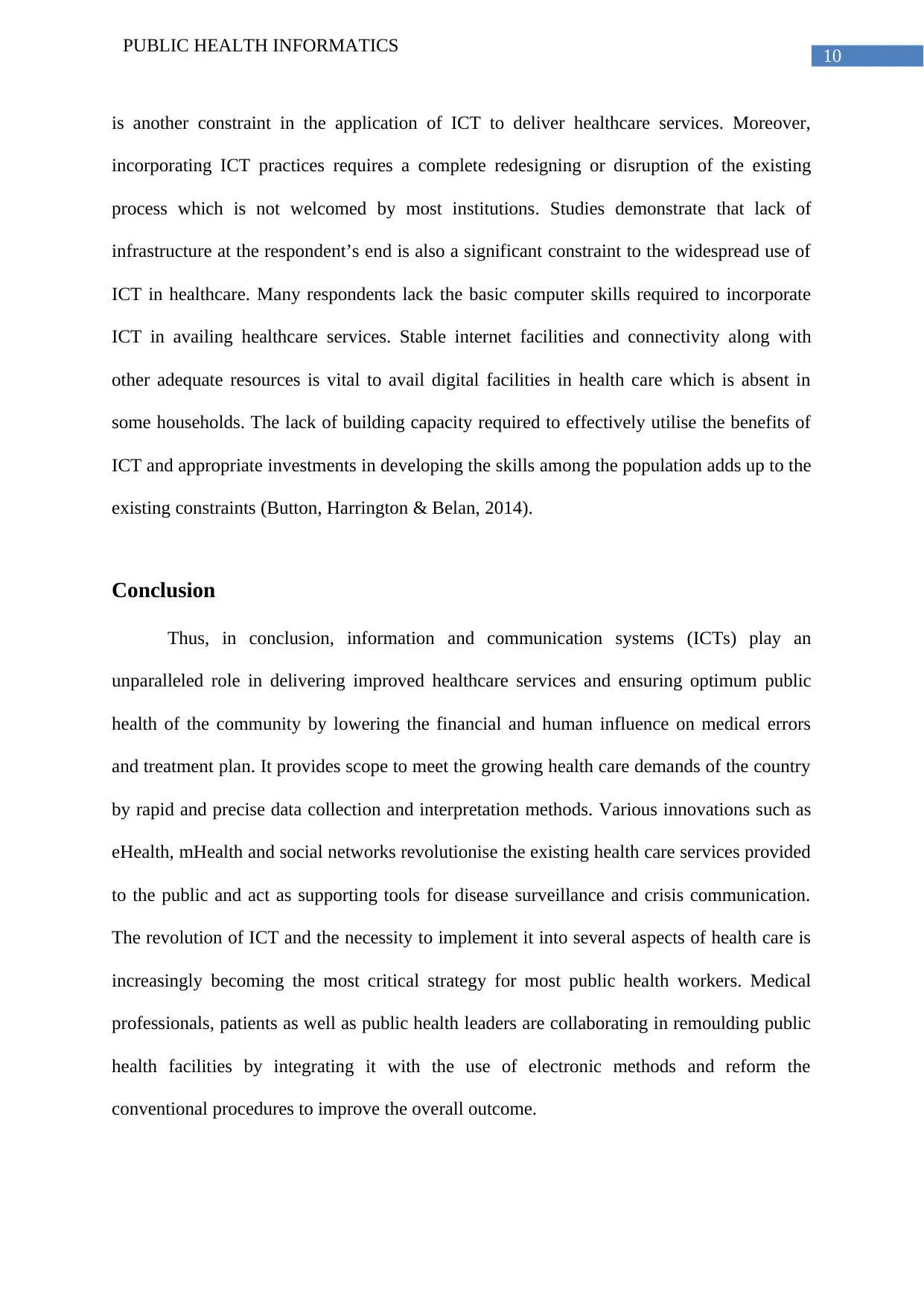
10
PUBLIC HEALTH INFORMATICS
is another constraint in the application of ICT to deliver healthcare services. Moreover,
incorporating ICT practices requires a complete redesigning or disruption of the existing
process which is not welcomed by most institutions. Studies demonstrate that lack of
infrastructure at the respondent’s end is also a significant constraint to the widespread use of
ICT in healthcare. Many respondents lack the basic computer skills required to incorporate
ICT in availing healthcare services. Stable internet facilities and connectivity along with
other adequate resources is vital to avail digital facilities in health care which is absent in
some households. The lack of building capacity required to effectively utilise the benefits of
ICT and appropriate investments in developing the skills among the population adds up to the
existing constraints (Button, Harrington & Belan, 2014).
Conclusion
Thus, in conclusion, information and communication systems (ICTs) play an
unparalleled role in delivering improved healthcare services and ensuring optimum public
health of the community by lowering the financial and human influence on medical errors
and treatment plan. It provides scope to meet the growing health care demands of the country
by rapid and precise data collection and interpretation methods. Various innovations such as
eHealth, mHealth and social networks revolutionise the existing health care services provided
to the public and act as supporting tools for disease surveillance and crisis communication.
The revolution of ICT and the necessity to implement it into several aspects of health care is
increasingly becoming the most critical strategy for most public health workers. Medical
professionals, patients as well as public health leaders are collaborating in remoulding public
health facilities by integrating it with the use of electronic methods and reform the
conventional procedures to improve the overall outcome.
PUBLIC HEALTH INFORMATICS
is another constraint in the application of ICT to deliver healthcare services. Moreover,
incorporating ICT practices requires a complete redesigning or disruption of the existing
process which is not welcomed by most institutions. Studies demonstrate that lack of
infrastructure at the respondent’s end is also a significant constraint to the widespread use of
ICT in healthcare. Many respondents lack the basic computer skills required to incorporate
ICT in availing healthcare services. Stable internet facilities and connectivity along with
other adequate resources is vital to avail digital facilities in health care which is absent in
some households. The lack of building capacity required to effectively utilise the benefits of
ICT and appropriate investments in developing the skills among the population adds up to the
existing constraints (Button, Harrington & Belan, 2014).
Conclusion
Thus, in conclusion, information and communication systems (ICTs) play an
unparalleled role in delivering improved healthcare services and ensuring optimum public
health of the community by lowering the financial and human influence on medical errors
and treatment plan. It provides scope to meet the growing health care demands of the country
by rapid and precise data collection and interpretation methods. Various innovations such as
eHealth, mHealth and social networks revolutionise the existing health care services provided
to the public and act as supporting tools for disease surveillance and crisis communication.
The revolution of ICT and the necessity to implement it into several aspects of health care is
increasingly becoming the most critical strategy for most public health workers. Medical
professionals, patients as well as public health leaders are collaborating in remoulding public
health facilities by integrating it with the use of electronic methods and reform the
conventional procedures to improve the overall outcome.
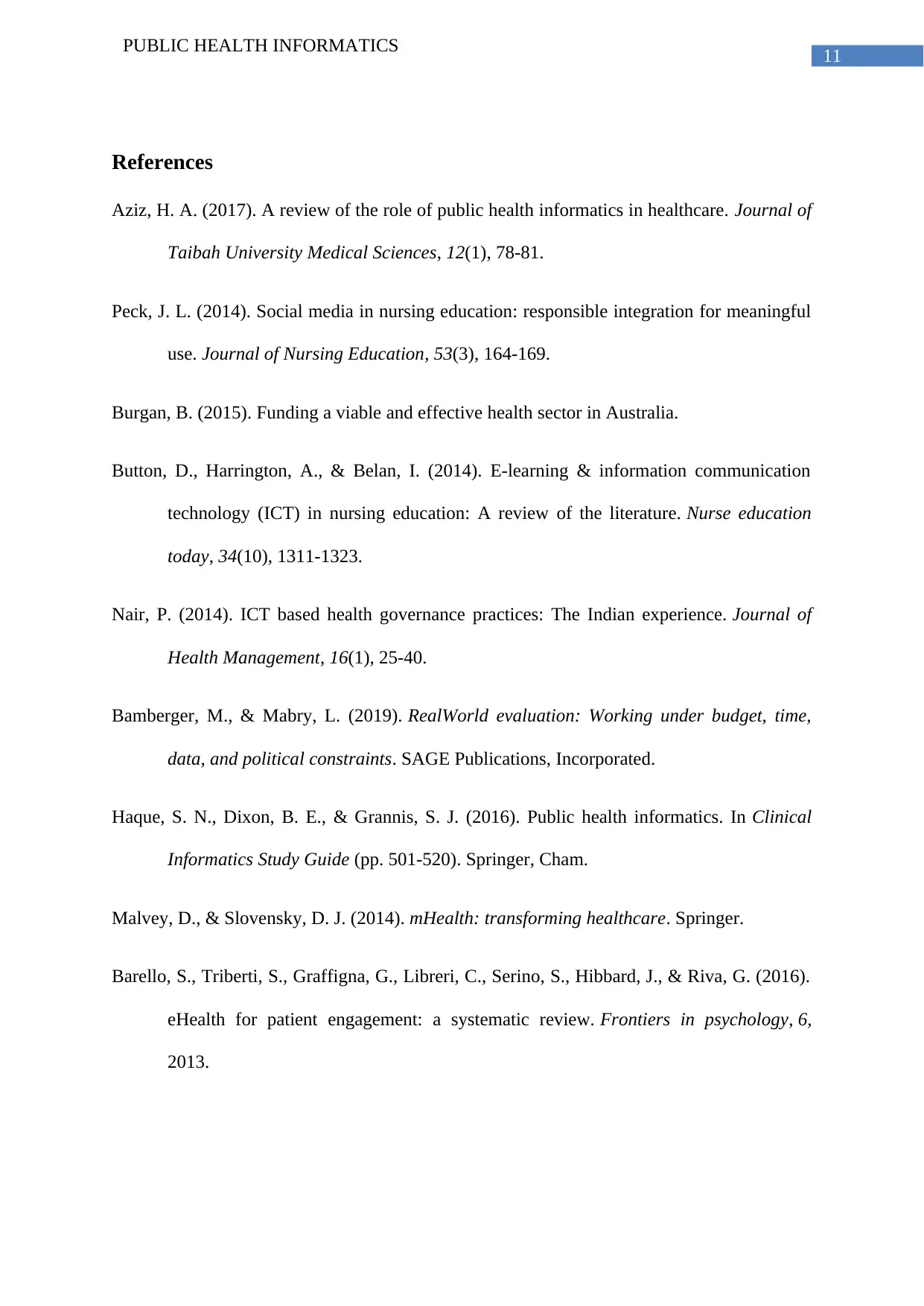
11
PUBLIC HEALTH INFORMATICS
References
Aziz, H. A. (2017). A review of the role of public health informatics in healthcare. Journal of
Taibah University Medical Sciences, 12(1), 78-81.
Peck, J. L. (2014). Social media in nursing education: responsible integration for meaningful
use. Journal of Nursing Education, 53(3), 164-169.
Burgan, B. (2015). Funding a viable and effective health sector in Australia.
Button, D., Harrington, A., & Belan, I. (2014). E-learning & information communication
technology (ICT) in nursing education: A review of the literature. Nurse education
today, 34(10), 1311-1323.
Nair, P. (2014). ICT based health governance practices: The Indian experience. Journal of
Health Management, 16(1), 25-40.
Bamberger, M., & Mabry, L. (2019). RealWorld evaluation: Working under budget, time,
data, and political constraints. SAGE Publications, Incorporated.
Haque, S. N., Dixon, B. E., & Grannis, S. J. (2016). Public health informatics. In Clinical
Informatics Study Guide (pp. 501-520). Springer, Cham.
Malvey, D., & Slovensky, D. J. (2014). mHealth: transforming healthcare. Springer.
Barello, S., Triberti, S., Graffigna, G., Libreri, C., Serino, S., Hibbard, J., & Riva, G. (2016).
eHealth for patient engagement: a systematic review. Frontiers in psychology, 6,
2013.
PUBLIC HEALTH INFORMATICS
References
Aziz, H. A. (2017). A review of the role of public health informatics in healthcare. Journal of
Taibah University Medical Sciences, 12(1), 78-81.
Peck, J. L. (2014). Social media in nursing education: responsible integration for meaningful
use. Journal of Nursing Education, 53(3), 164-169.
Burgan, B. (2015). Funding a viable and effective health sector in Australia.
Button, D., Harrington, A., & Belan, I. (2014). E-learning & information communication
technology (ICT) in nursing education: A review of the literature. Nurse education
today, 34(10), 1311-1323.
Nair, P. (2014). ICT based health governance practices: The Indian experience. Journal of
Health Management, 16(1), 25-40.
Bamberger, M., & Mabry, L. (2019). RealWorld evaluation: Working under budget, time,
data, and political constraints. SAGE Publications, Incorporated.
Haque, S. N., Dixon, B. E., & Grannis, S. J. (2016). Public health informatics. In Clinical
Informatics Study Guide (pp. 501-520). Springer, Cham.
Malvey, D., & Slovensky, D. J. (2014). mHealth: transforming healthcare. Springer.
Barello, S., Triberti, S., Graffigna, G., Libreri, C., Serino, S., Hibbard, J., & Riva, G. (2016).
eHealth for patient engagement: a systematic review. Frontiers in psychology, 6,
2013.
⊘ This is a preview!⊘
Do you want full access?
Subscribe today to unlock all pages.

Trusted by 1+ million students worldwide
1 out of 13
Related Documents
Your All-in-One AI-Powered Toolkit for Academic Success.
+13062052269
info@desklib.com
Available 24*7 on WhatsApp / Email
![[object Object]](/_next/static/media/star-bottom.7253800d.svg)
Unlock your academic potential
Copyright © 2020–2025 A2Z Services. All Rights Reserved. Developed and managed by ZUCOL.




